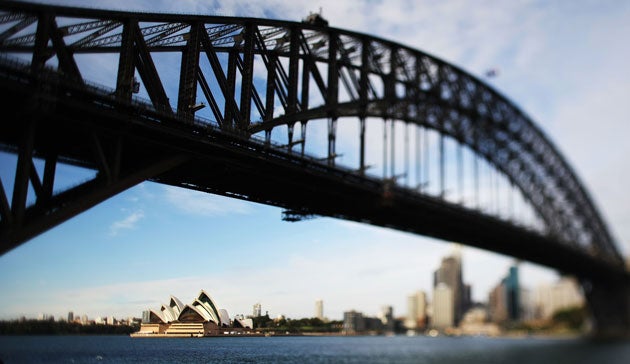Honoured at last: man behind Sydney Opera House

Your support helps us to tell the story
From reproductive rights to climate change to Big Tech, The Independent is on the ground when the story is developing. Whether it's investigating the financials of Elon Musk's pro-Trump PAC or producing our latest documentary, 'The A Word', which shines a light on the American women fighting for reproductive rights, we know how important it is to parse out the facts from the messaging.
At such a critical moment in US history, we need reporters on the ground. Your donation allows us to keep sending journalists to speak to both sides of the story.
The Independent is trusted by Americans across the entire political spectrum. And unlike many other quality news outlets, we choose not to lock Americans out of our reporting and analysis with paywalls. We believe quality journalism should be available to everyone, paid for by those who can afford it.
Your support makes all the difference.More than 40 years after Joern Utzon was forced off the site of the Sydney Opera House, the building's visionary designer was finally honoured by Australia today at a memorial service held inside the masterpiece that he never saw completed.
The Danish architect won an international design competition in 1954 but stormed off the project in 1966 after a row with the New South Wales government about spiralling costs. He left Australia, vowing never to return, and relations only thawed in recent years, when he accepted an invitation to be principal design consultant on a revamp of the building.
Mr Utzon died last November, aged 90. Politicians, dignitaries and major figures in the art world came together yesterday to celebrate the legacy that he left Australia.
The federal Arts Minister, Peter Garrett, hailed the Opera House as "one of the defining symbols of Sydney and Australia", and said it had played a significant role in the evolution of the nation's cultural identity. The service was attended by Mr Utzon's children, Jan and Lin, and featured performances by the Sydney Symphony Orchestra, Opera Australia and the Australian Ballet, underlining the architect's contribution to the country's arts.
The Oscar-winning actress Cate Blanchett read from Shakespeare's Cymbeline, while Neil Finn, from the band Crowded House, performed the group's hit "Don't Dream It's Over".
Despite the decades-long suspension of official contact, Australians adored Mr Utzon's modernist icon, which opened in the shadow of the Harbour Bridge in 1973. The architect received warm letters from the public throughout his life, according to his son, who was also his professional partner.
Jan told the service that one woman wrote to say she had been planning to kill herself by leaping into the harbour but had changed her mind after seeing the Opera House's distinctive roof of billowing sails reflected in the water.
While Jan has visited Australia regularly since 1999 to co-ordinate the redesign work, his father was too frail to make the journey from Europe.
Jan said he was sure his father "would have liked [past] events to happen differently", but he had been delighted to be part of the Opera House project for so many years.
"The thing that touched him most was my accounts of how people used the building, how they loved the building, and of their respect for his work," Jan said. His sister Lin added: "He created a building so beautiful and so, in a way, self-evident that it seems as if God himself put it there."
Mr Utzon, whose philosophy was to "work on the edge of the possible", bet more than 200 others to win the competition to design the Opera House. Work began in 1959, but the construction schedule grew ever more elastic – a four-year project ended up taking 17 years – and the budget soared from A$7m (£3.4m) to A$100m.
Amid increasing public disquiet, Mr Utzon was sacked by the government. His plans were scrapped, and the building's interior was completed by a team of inexperienced local architects.
The epic falling-out enthralled Australians and later became the subject of an opera by the composer Alan John. It was called Eighth Wonder and was performed at the Opera House in 1995.
Yesterday, the New South Wales Premier, Nathan Rees, praised Mr Utzon's creation – which is Australia's biggest tourist attraction and the world's busiest performing arts centre – as more than just a building. "It binds us as a community, as a people, as a nation," he said.
The service began with a traditional Aboriginal welcome ceremony at dawn on the steps of the Opera House. Later, the internationally renowned indigenous Bangarra Dance Theatre performed inside the concert hall.
Mr Utzon, whose magnum opus won World Heritage status in 2007, created a set of design principles to govern any future redevelopment. The state government is considering a $1bn (£480m) facelift of the building.
Join our commenting forum
Join thought-provoking conversations, follow other Independent readers and see their replies
Comments